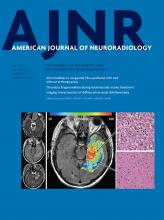Abstract
BACKGROUND AND PURPOSE: Dilated perivascular spaces in the brain are associated with greater arterial pulsatility. We hypothesized that perivascular spaces identify individuals at higher risk for systemic and cerebral vascular events.
MATERIALS AND METHODS: Stroke-free participants in the population-based Northern Manhattan Study had brain MR imaging performed and were followed for myocardial infarction, any stroke, and death. Imaging analyses distinguished perivascular spaces from lesions presumably ischemic. Perivascular spaces were further subdivided into lesions with diameters of ≤3 mm (small perivascular spaces) and >3 mm (large perivascular spaces). We calculated relative rates of events with Poisson models and hazard ratios with Cox proportional models.
RESULTS: The Northern Manhattan Study participants who had MR imaging data available for review (n = 1228; 59% women, 65% Hispanic; mean age, 71 ± 9 years) were followed for an average of 9 ± 2 years. Participants in the highest tertile of the small perivascular space score had a higher relative rate of all deaths (relative rate, 1.38; 95% CI, 1.01–1.91), vascular death (relative rate, 1.87; 95% CI, 1.12–3.14), myocardial infarction (relative rate, 2.08; 95% CI, 1.01–4.31), any stroke (relative rate, 1.79; 95% CI, 1.03–3.11), and any vascular event (relative rate, 1.74; 95% CI, 1.18–2.56). After we adjusted for confounders, there was a higher risk of vascular death (hazard ratio, 1.06; 95% CI, 1.01–1.11), myocardial infarction (hazard ratio, 2.22; 95% CI, 1.12–4.42), and any vascular event (hazard ratio, 1.04; 95% CI, 1.01–1.08) with higher small perivascular space scores.
CONCLUSIONS: In this multiethnic, population-based study, participants with a high burden of small perivascular spaces had increased risk of vascular events. By gaining pathophysiologic insight into the mechanism of perivascular space dilation, we may be able to propose novel therapies to better prevent vascular disorders in the population.
ABBREVIATIONS:
- HR
- hazard ratio
- LPI
- lesions presumably ischemic
- MI
- myocardial infarction
- NOMAS
- Northern Manhattan Study
- PP
- pulse pressure
- PVS
- perivascular space
- RR
- relative rate
- WMHV
- white matter hyperintensity volume
- © 2017 by American Journal of Neuroradiology
Indicates open access to non-subscribers at www.ajnr.org












